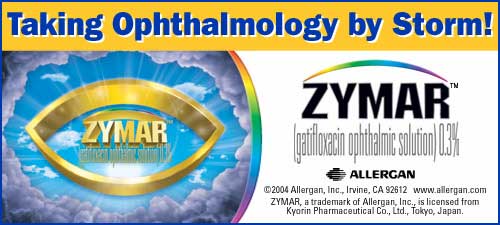
| |
Volume 4, Number 51
|
Monday, December 20, 2004
|

|
||
| Lutein and Zeaxanthin
in Vegetables May Help Prevent Cataracts Epidemiological studies suggest that consumption of vegetables rich in the xanthophylls lutein (LUT) and zeaxanthin (ZEA) reduces the risk for developing age-related cataract, a leading cause of vision loss. Although LUT and ZEA are the only dietary carotenoids present in the lens, direct evidence for their photoprotective effect in this organ is not available. A study by the Ohio State University Interdisciplinary PhD Program in Nutrition and Department of Human Nutrition examined the effects of xanthophylls and alpha-tocopherol (alpha-TC) on lipid peroxidation and the mitogen-activated stress signaling pathways in human lens epithelial (HLE) cells following ultraviolet B light (UVB) irradiation. When presented with LUT, ZEA, astaxanthin (AST) and alpha-TC as methyl-beta-cyclodextrin complexes, HLE cells accumulated the lipophiles in a concentration- and time-dependent manner, with uptake of LUT exceeding that of ZEA and AST. Pre-treatment of cultures with either xanthophyll or alpha-TC for four hours before exposure to UVB radiation decreased lipid peroxidation by 47 to 57 percent, compared with UVB-treated control HLE cells. Pre-treatment with the xanthophylls and alpha-TC also inhibited UVB-induced activation of c-JUN NH(2)-terminal kinase (JNK) and p38 by 50 to 60 percent and 25 to 32 percent, respectively. There was substantial inhibition of UVB-induced JNK and p38 activation for cells containing less than 0.20 and approximately 0.30 nmol xanthophylls/mg, respectively, whereas greater than 2.3 nmol alpha-TC/mg protein was required to significantly decrease UVB-induced stress signaling. These data suggest that xanthophylls are more potent than alpha-TC for protecting human lens epithelial cells against UVB insult. The authors believe that their results are the first to provide physical evidence suggesting that lutein and zeaxanthin decrease damage caused by UV radiation. |
|
SOURCE: Chitchumroonchokchai C, Bomser JA, Glamm JE, Failla ML. Xanthophylls and {alpha}-tocopherol decrease UVB-induced lipid peroxidation and stress signaling in human lens epithelial cells. J Nutr 2004;134(12):3225-32. |
|

|
||
| Retinal Vascular
Caliber and Blood Flow in CADASIL Cerebral autosomal dominant arteriopathy with subcortical infarcts and leukoencephalopathy (CADASIL) is a progressive systemic nonatherosclerotic angiopathy that causes ischemic strokes and vascular subcortical dementia. Investigators at Finland’s Helsinki University Central Hospital performed a cross-sectional study to examine retinal vascular caliber and blood flow in CADASIL. Researchers used scanning laser Doppler flowmetry in a case-control study (11 patients and controls) of peripapillary retinal circulation. They used automated full-field perfusion image analysis to analyze the flow data. They measured retinal vessel calibers from retinal images acquired with scanning laser ophthalmoscopy and measured the caliber of the superior and inferior temporal retinal artery and vein 1 and 2 mm from the disc rim. The mean values were used for analysis. Retinal capillary peak systolic flow was lower, and mean capillary flow and minimum diastolic flow tended to be lower in patients than in controls. No significant difference in the calibers of proximal retinal arteries and veins was found between the patients and controls. The authors conclude that retinal capillary blood flow is mildly to moderately reduced in CADASIL, but that the reduction does not appear to cause major ischemic injury. Such reduction is analogous to that in the cerebral cortex in CADASIL patients with which retina appears to share its relative sparing from severe arterial ischemic tissue damage. |
|
SOURCE: Harju M, Tuominen S, Summanen P, et al. Scanning laser Doppler flowmetry shows reduced retinal capillary blood flow in CADASIL. Stroke 2004;35(11):2449-52. |
|

|
||
| Regional and
Distant Metastasis with Eyelid and Periocular Squamous Cell Carcinoma
The University of Texas M. D. Anderson Cancer Center in Houston conducted a retrospective case series study aimed at determining the frequency and location of regional lymph node metastasis in patients with squamous cell carcinoma (SCC) of the eyelid and periocular skin. Patterns of distant metastasis were also investigated. The study included 111 patients treated at the cancer center for SCC of the eyelid and periocular skin between 1952 and 2000. Clinical records of all patients were retrospectively reviewed for age, gender, location of lesion, treatment modalities, patterns of regional nodal and distant metastasis and perineural invasion. Follow-up time ranged from six to 484 months (median, 76.6 months). The most common sites of SCC were the lower eyelid (54 patients, 48.6 percent), the medial canthus (40 patients, 36 percent), and the upper eyelid (25 patients, 22.5 percent). Local treatment of SCC consisted of wide local excision with frozen section analysis to ensure negative margins in 96 patients (86.4 percent), radiotherapy (without surgery) in seven patients, and primary exenteration because of extensive tumor in seven patients. Local recurrence occurred in 41 patients (36.9 percent). Twenty-seven patients (24.3 percent) had regional nodal metastasis during the study period. Sixteen of these patients had regional lymph node metastasis at the time of the initial presentation to the cancer center. Eleven developed regional nodal disease later. Seven patients (6.2 percent) had distant metastasis during the study period, and nine patients (8.1 percent) had perineural invasion. This study results indicate that the overall rate of regional lymph node metastasis in patients with SCC of the eyelid or periocular skin may be as high as 24 percent. Thus, careful surveillance of the regional lymph nodes is an important aspect of the initial management of eyelid or periocular skin SCC. The authors recommend that practitioners consider studying sentinel lymph node biopsy as a technique to stage SCC of the eyelid or periocular skin more accurately, especially in patients with recurrent, large or highly invasive lesions or with perineural invasion. |
|
SOURCE: Faustina M, Diba R, Ahmadi MA, et al. Patterns of regional and distant metastasis in patients with eyelid and periocular squamous cell carcinoma. Ophthalmol 2004;111(10):1930-2. |
|
BRIEFLY
|
|
|
||||||||||||||
| Subscriptions: Review of Ophthalmology Online
is provided free of charge as a service of Jobson Publishing, LLC. If
you enjoy reading Review of Ophthalmology Online, please tell a
friend or colleague about it. Forward this newsletter or send this address:
[email protected].
To change your subscription, reply to this message and give us your old
address and your new address; type "Change of Address" in the
subject line. If you do not want to receive Review of Ophthalmology
Online, reply to this message and type "Unsubscribe: Review of Ophthalmology
Online" in the subject line. Advertising: For information on advertising in this e-mail newsletter or other creative advertising opportunities with Review of Ophthalmology, please contact publisher Rick Bay, or sales managers James Henne or Michele Barrett. News: To submit news, send an e-mail, or FAX your news to 610.492.1049 |
















